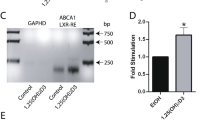Summary
In man ketanserin tartrate reduces plasma LDL cholesterol. To clarify the mechanism of this effect the effect of ketanserin on 3-hydroxy-3-methylglutaryl (HMG) CoA reductase and LDL receptor activity in cultured human skin fibroblasts has been examined.
After incubation with ketanserin for 14 h HMG CoA reductase activity was decreased in a dose-dependent manner up to 300 ng/ml (550 nM) without changing the free cholesterol content in the cells. Ketanserin increased specific binding and specific internalization of 125I-LDL dose-dependently. There was a significant inverse relationship between the percentage changes in HMG CoA reductase and LDL receptor activity.
It appears that ketanserin induces up-regulation of LDL receptor activity by direct suppression of HMG CoA reductase, and this may be one mechanism by which plasma LDL-cholesterol is reduced by ketanserin.
Similar content being viewed by others
References
Dawber TR, Meadors GF and Moore FE (1951) Epidemiological approaches to heart disease. The Framingham Study. Am J Pub Health 41: 279–286
Kannel WB, Castelli WP and Gordon T (1979) Cholesterol in the prediction of atherosclerotic disease. New perspective based on Framingham study. Ann Intern Med 90: 85–91
Veterans Administration Cooperative Study Group on Antihypertensive Agents (1970) Effects of treatment on morbidity in hypertension. Results in patients with diastolic blood pressure averaging 90 though 114 mm Hg JAMA 213: 1143–1152
Veterans Administration Cooperative Study Group on Antihypertensive Agents (1972) Effects of treatment on morbidity in hypertension. Influence of age, diastolic pressure and prior cardiovascular disease. Further analysis of side effects. Circulation 45: 991–1004
U.S. Public Health Service Hospitals Cooperative Study Group (1977) Treatment of mild hypertension. Results of a ten-year intervention trial. Circ Res 40 [Suppl 1]: 198–1105
Multiple Risk Factor Intervention Trial Research Group (1982) Multiple risk factor changes and mortality results. JAMA 248: 1465–1477
Nakamura H (1987) Effects of antihypertensive drugs on plasma lipids. Am J Cardiol 60: 24E-28E
Leysen JE, Awouters F, Kennis L, Laduron PM, Vandenberk J and Janssen PAJ (1981) Receptor binding profile of R41468, a novel antagonist at 5-HT2 receptors. Life Sci 28: 1015–1022
Nakamura H, Hirata F, Yasugi T, Mizuno M, Saito E, Ishikawa T, Tada N, Nakaya N, Honma Y and Takeuchi I (1988) Effects of ketanserin tartrate on serum lipids in patients with essential hypertension. Drugs 36 [Suppl 1]: 25–34
Lijnen P, Fagard R, Staessen J, Blaton V, Hollez P, Rorive G, and Amery A (1987) Serum cholesterol during ketanserin and propranolol administration in hypertensive patients. J Cardiovasc Pharmacol 10: 647–650
Brown MS and Goldstein JL (1979) Receptor-mediated endocytosis: Insight from the lipoprotein receptor system. Proc Natl Acad Sci USA 76: 3330–3337
Brown MS, Kovanen PT and Goldstein JL (1981) Regulation of plasma cholesterol by lipoprotein receptors. Science 212: 628–635
Goldstein JL, Basu SK and Brown MS (1983) Receptor-mediated endocytosis of low-density-lipoprotein in cultured cells. Methods Enzymol 98: 241–260
Lowry OH, Rosebrough NJ, Farr AL and Randall TR (1951) Protein measurements with folin phenol reagent. J Biol Chem 193: 265–275
Bligh EG and Dyer WJ (1959) A rapid method of total lipid extraction and purification. Can J Biochem Physiol 37: 911–917
Havel RL, Eder HA and Bragon JH (1955) The distribution and chemical composition of ultracentrifugally separated lipoprotein in human serum. J Clin Invest 34: 1345–1353
Salacinski PRP, McLean C and Sykes JEC (1981) Iodination of protein, glycoproteins, and peptides using a solid-phase oxidizing agents, 1,3,4,6-Tetrachloro-3α,6α-diphenylglycoluril (Iodogen). Anal Biochem 117: 136–146
Sparrow CD, Parthasaratly S and Steinberg D (1989) A macrophage receptor that recognizes oxidized low density lipoprotein but not acetylated low density lipoprotein. J Biol Chem 264: 2599–2604
Suzukawa M and Nakamura H (1990) Effects of ketanserin on HMG CoA reductase activity in cultured human skin fibroblasts. Cardiovasc Drug Ther 4: 67–70
Mitropoulos KA, Venkatesen S, Reeves BEA and Balasubramaniam S (1981) Modulation of 3-hydroxy-3-methylglutaryl-CoA reductase and of acly-CoA-cholesterol acyltransferase by the transfer of non-esterified cholesterol to rat liver microsomal vesicles. Biochem J 194: 265–271
D'Eletto RD and Javitt NB (1989) Effect of Doxazosin on cholesterol synthesis in cell culture. J Cardiovasc Pharmacol 13 [Suppl 2]: S1-S4
Jansen H, Lammers R, Baggen MGA and Birkenhaber JC (1989) Effects of doxazosin on lipids, lipoprotein lipases, and cholesterol synthesis in the golden hamster. J Cardiovasc Pharmacol 13 [Suppl 2]: S5-S10
Kennelly PJ and Rodwell VW (1985) Regulation of 3-hydroxy-3-methylglutaryl coenzyme A reductase by reversible phosphorylation-dephosphorylation. J Lipid Res 26: 903–914
Gunten CF and Sinensky M (1989) Treatment of CHO-K1 cells with 25-hydroxy-cholesterol produces a more rapid loss of 3-hydroxy-3-methylglutaryl coenzyme A reductase activity than can be accounted for by enzyme turnover. Biochim Biophys Acta 1001: 218–224
Leren TP (1985) Doxazosin increases low-density-lipoprotein receptor activity. Acta Pharmacol Toxicol 56: 269–272
Aviram M (1989) Platelet secretory products enhance LDL receptor activity and inhibit scavenger receptor activity in human monocyte derived macrophages. Metabolism 38: 425–430
Author information
Authors and Affiliations
Rights and permissions
About this article
Cite this article
Suzukawa, M., Nakamura, H. Effect of ketanserin tartrate on HMG CoA reductase and LDL receptor activity in cultured human skin fibroblasts. Eur J Clin Pharmacol 39, 217–220 (1990). https://doi.org/10.1007/BF00315099
Received:
Accepted:
Issue Date:
DOI: https://doi.org/10.1007/BF00315099




